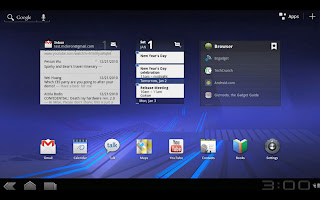When it comes to smartphones, how big is too big?
Samsung obviously isn’t preoccupied with that question, as evidenced by its latest Android device release, the Infuse 4G.
As soon as you pop the phone out of the box, the first thing you notice is its size. The thing is massive. It needs to be, though, in order to support its 4.5-inch super AMOLED display. Save for the first Dell Streak smartphone-cum-tablet hybrid — whose screen is a whopping 5-inches — the Infuse is packing one of the largest screens we’ve seen on a smartphone.
This is a good thing. I watched the HD trailer for Cowboys and Aliens on the little silver screen and could practically feel the trail dust on my face. The picture quality was excellent, and as bright as can be. I did wish the Infuse came with a little kickstand for my movie watching, something akin to what the HTC Thunderbolt has on its back. With this phone’s slick edges, it won’t be very stable propped up on my airplane tray table during a long flight.
After seeing how well the screen handled the trailer, I could see myself using Samsung’s Media Hub store, which lets you download from a library of thousands of HD movies. To sweeten the pot, Samsung throws in a $25 credit with the phone, which is enough to rent about 6 films.
Size has its disadvantages. After sitting down with the phone in my pocket, it felt a bit like a splint trying to straighten my upper thigh. And I don’t even wear skinny jeans.
But for being such a fatty in pure surface area, the thickness of the phone is surprisingly svelte. Samsung boasts that the Infuse is the “thinnest 4G smartphone out there today.” It’s light, too. Airy, not terribly bulky, if not a little too light. I personally prefer a bit more heft in my device — one of my biggest complaints with its Nexus S brother was the light, plasticky build that made me feel that I’d break it if I wasn’t delicate enough.
The removable plastic backing that protects the phone’s innards is thin and flimsy. It practically peels off the back of the handset, and I was worried I’d snap it in half while I took it off to look under the hood.
Samsung included a few perks that I don’t often see come with other phones. The Infuse comes with a 2-GB micro SD card, saving you a trip to Radio Shack. It also comes with a microSD adapter card, so if you’ve got a regular-sized card reader built into your laptop, transferring files is easy as pie.
An issue: The phone doesn’t have HDMI-out on the handset itself (Samsung probably ran out of room, being its “thinnest” phone to date), which is a bummer. Samsung remedies this, however, with an included MHL adapter. With a screen this big, you may wonder if you need anything else, but you might find times when an HDTV is easier to watch.
Like every other 2011 Android smartphone release, the phone doesn’t ship with the latest version of Android 2.3 (Gingerbread), but instead runs 2.2 (Froyo).
Listen up, bird-chucking addicts: The Infuse 4G comes bundled with a copy of Angry Birds, complete with hidden level only available to Infuse owners. Whoop.
Both the 8-megapixel back-facing camera and 1.3-megapixel front-facing camera take clear, crisp photos, which can be auto-uploaded to an AT&T-hosted online locker for storage or sharing, which I found pretty cool.
Overall, Samsung has created a media hub, as much as a smartphone, in the Infuse 4G. All of the included attachments practically beg for you to use it as such, and from my initial tests, it delivers.
As for the phone’s performance on AT&T’s network, that’s something to be saved for a longer review.
Beginning May 15, the phone will be available on AT&T’s HSPA+ 4G network for $200 with a two-year contract.








